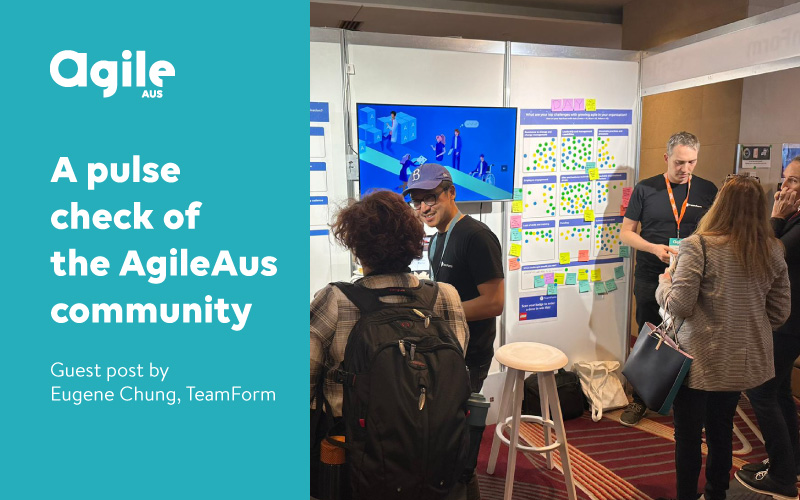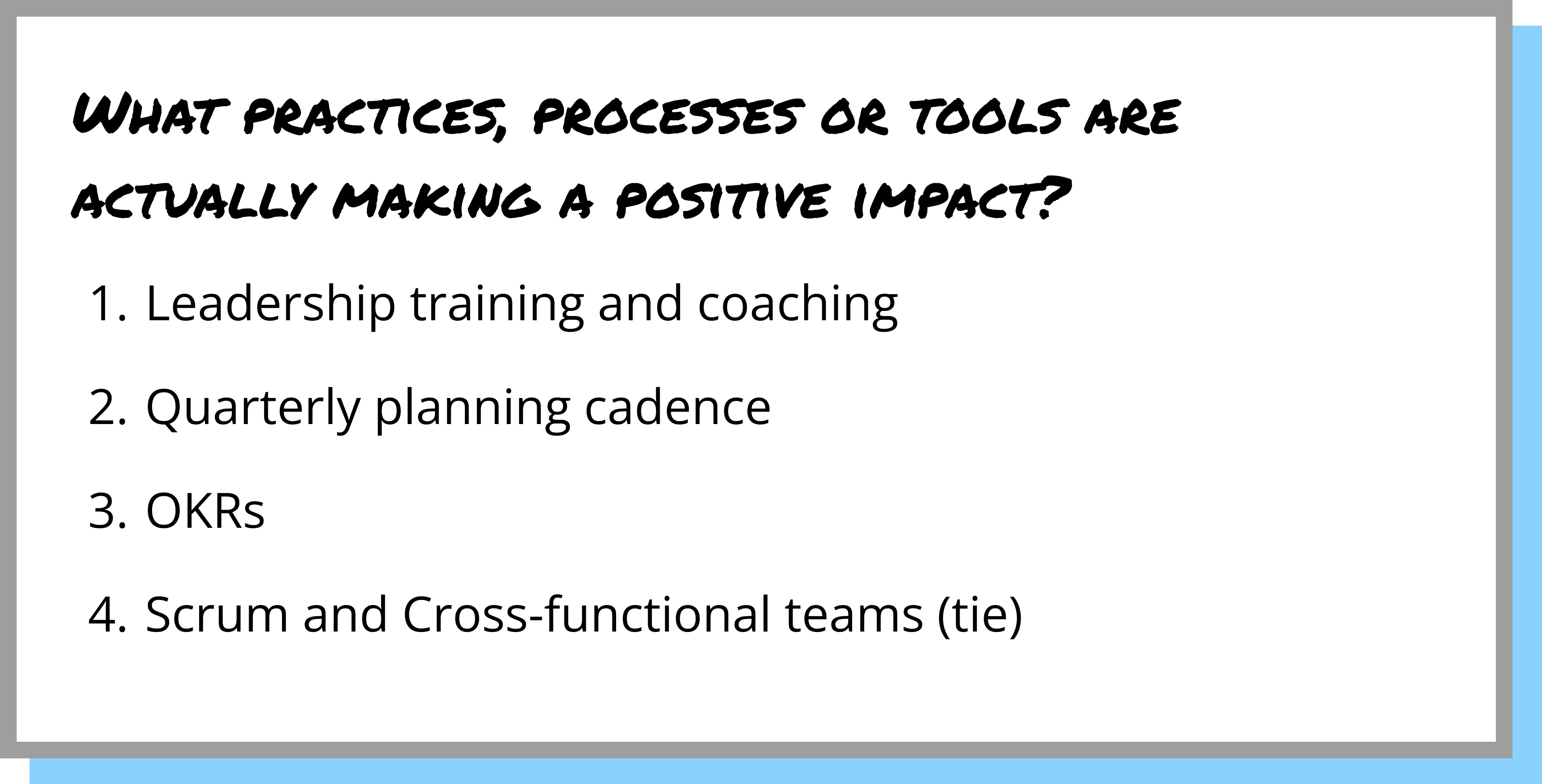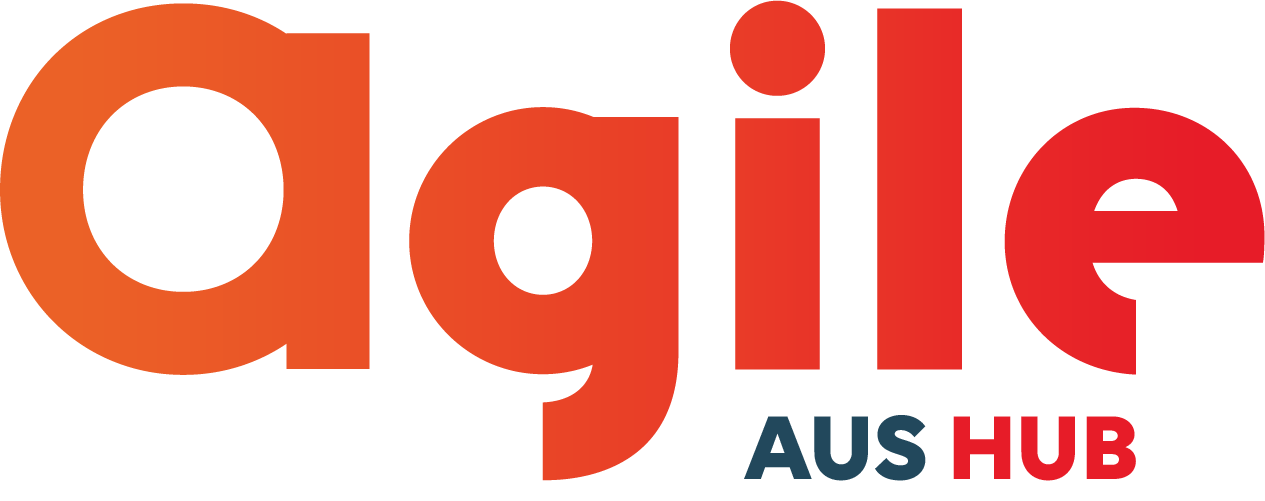
A pulse check of the Agile Australia community
As one of the event sponsors for AgileAus23 last week, we at TeamForm wanted to use the event to learn from the community by getting a pulse check of the challenges we’re experiencing today and which agile practices, processes and tools are actually making a positive impact.
To help us do this, we set up an informal research wall where people could visit and share their own perspectives, observations and experiences. Across both days, more than 100 people stopped by – thank you to everyone who participated!
In this blog post, we’ll share what we learned. We know this research is imperfect, but we hope it will provide some insight into where we’re at as a community, and how we can best focus to overcome the challenges we’re experiencing.
The challenges in the way of growing agility within our organisations

The biggest challenge was around leadership, which trickles down into organisational culture, mindset, and a resistance to change.
With so many organisations already well along their agile transformation journey, the biggest challenge that the AgileAus community identified was around leadership and management capabilities, with a specific call out around “leaders expecting teams to change, but not being open to changing themselves”. This aligns well with global trends identified in the 2022 Business Agility Report.
This mindset trickles down into the rest of the organisation, creating cultures that are “too busy to change” and leaders having a “desire for change, but not wanting to let go of power and control.”
The next set of challenges extend beyond the team into the organisational level: silos, the business-technology divide, and having a clear vision and strategy.
The adoption of agile across organisations is disparate, leading to siloed pockets that are working in different ways with different mindsets. This was observed in the product development flow itself (e.g., “different codebases and different repos across the organisation, making it harder to collaborate with other business units”) and challenges with different paces of change (“we’re trying to move faster than the organisation can absorb”, “we’ve moved into a new model but tech hasn’t changed”).
When strategy and priorities aren’t clear, it can lead to real challenges for teams in having to balance “growth in scope (due to lack of prioritisation), with delivering decreasing quality and value”.
The practices, processes or tools that are actually making a difference

Enabling leaders through training and coaching creates a high-impact ripple effect that spreads throughout the organisation.
We know “leadership capabilities” was cited as the community’s biggest challenge, so it should come as no surprise that it’s also the area of highest positive impact. Whether it’s through more 1:1 coaching, or specific training programs dedicated for leaders (e.g., “multi-day training programs specifically for the Director level”), we heard that investing in supporting behaviour change at the leadership level is a high-impact part of the transformation toolkit.
What “good” looks like here is when “leadership are walking the walk” and they’re able to promote “a growth mindset and create psychological safety” and “support for experimentation”. When priorities are clear from executive leaders, it makes it “easier for teams to say ‘no’ to stuff”.
The AgileAus community is using a diverse range of practices, processes, and tools based on the unique context and needs of each team and organisation.
The range of practices was diverse and reflects the extensive toolkit the AgileAus community has to draw from. While we pre-identified a few practices to start our research, the community added a lot of other practices that made a big difference, for example: 1-pagers, creating a repository of knowledge/documentation, roadmaps to align on priorities, and even more individual practices, such as requesting help from teammates (e.g., “asking others for help – do you have a couple minutes?”).
These practices, processes and tools were largely dependent on the organisational context and where each community member works – individual teams, teams-of-teams, and org-wide.
There was some mention of software, but the practices making the biggest impact were around creating shared understanding and alignment across the organisation: quarterly planning cadences, OKRs, and having a shared taxonomy.
While these practices are “really hard” to implement, when done well, it can create clarity across the organisation that tangibly impacts the teams and their work. When clarity doesn’t exist, “it’s the #1 source of friction” and “everything is chaos”.
While high value, there’s still a lot of work to do in improving use of OKRs, with one respondent sharing that “OKRs are really hard – measuring is difficult” and that they’re still trying to “understand the difference between aspirational vs committed OKRs”.
Two things you can do
One thing I’ve been reflecting on since AgileAus23 wrapped is that highlighting challenges is easy. Especially at a conference where you’re surrounded by like-minded people, it’s easy to be open and transparent about what’s holding you back.
What’s genuinely hard is to do something about it. To be brave enough to speak up and to challenge the status quo.
To help provoke some action, here are two things you can do:
Talk to your team. Start the next conversation around the challenges you’re facing and the practices you want to experiment with next. Be the change you want to see in your organisation. Start with these questions:
- What’s working well? What’s holding us back?
- How can we work together to improve?
- What is one practice, process or tool that we believe will make a positive impact?
From there, start small while doing, reflecting, and improving together.
Continue connecting with the community. Reach out to others, share your wins and your failures, and support others who need help. Continue giving back to others, whether through AgileAus, meetups or on LinkedIn.
Like the research? Take 10 minutes and contribute your voice and experience to the 2023 Business Agility Survey, and be the first to be notified when the 2023 report is published.
When we learn together as a community, we all grow. And as Jon Smart puts it, “let’s become the best at getting better”.
Eugene Chung is Product Evangelist and Coach at TeamForm. Learn more about TeamForm here or follow them on LinkedIn.

0 Comments